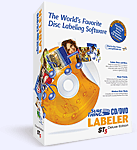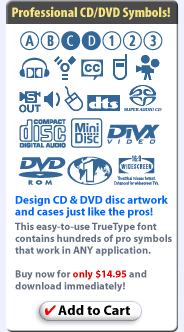 |
This is referred to as a "sound mode icon," and
this one in particular indicates the disc contains 1-channel Dolby Digital
audio (mono). A mono channel is often used for DVD content such as director
commentary.
|
 |
Disc contains 2-channel Dolby Digital audio (stereo).
|
 |
Disc contains 3-channel Dolby Digital audio (surround).
|
 |
Disc contains 5.1 Dolby Digital audio, i.e., surround with
a LFE (low-frequency effects) channel.
|
 |
Dolby Digital Surround EX, a system co-developed by Dolby
and Lucasfilm, was first used theatrically for Star Wars: Episode 1. Dolby
Digital Surround EX soundtracks contain 5.1 channels of discrete audio, plus
an additional matrix encoded surround channel. These DVDs are compatible with
all playback systems and provide an enhanced surround effect when used with
a Surround EX enabled system.
|
 |
6.1 channel surround from DTS, a competitor to Dolby. This
format adds a rear center speaker to the surround sound package found on selected
music and movie discs.
|
 |
THX EX is 7.1 channel surround from Lucasfilm. There aren't
many movies encoded with 7.1 (all the new Star Wars films are), nor many preamps
to play it. You'd also have to add more speakers to your system. If you have
such a setup, can we come over?
|
 |
DTS was developed for “Jurassic Park” in 1993
and is the main competitor to Dolby Digital in the AV market. DTS’ advantage
over Dolby is its 3:1 compression versus 12:1. Most current receivers and
preamps are capable of playing both Dolby 5.1 and DTS surround DVDs.
|
 |
Stands for Meridian Lossless Packing, a lossless compression
scheme used on DVD-Audio to get the highest resolution surround sound and
stereo music from a DVD disc. DVD-Audio sounds better than the 16-bit audio
on CDs.
|
 |
The disc is playable only in DVD players from region 1, i.e.,
North America. There are eight regions (seven geographical and an eighth reserved
for airlines, cruise ships, etc.).
|
 |
The disc is playable in DVD players from all regions of the
world.
|
 |
NTSC stands for the National Television Systems Committee,
and is the color video standard used in North America, Canada, Mexico, and
Japan. NTSC uses 525 horizonal lines of which only 487 make up the active
picture. It's an inferior video standard compared to PAL (below).
|
 |
PAL stands for Phase Alternating Line, and is the TV standard
used in Europe and much of Asia. It was designed to correct problems in the
NTSC system. PAL uses 625 horizontal lines, of which 576 are used for the
picture. In other words, it has roughly one sixth more resolution than NTSC,
resulting in better color and sharper resolution.
|
 |
The disc contains video content with an aspect ratio of 1.33:1
(or 4:3). This is the basic dimension of a television monitor.
|
 |
The disc contains video content with an aspect ratio of 1.78:1
(or 16:9), also referred to as "anamorphic widescreen." In addition
to 1.78:1, there are other anamorphic screen ratios such as 1.66:1, 1.85:1
and 2.35:1 and 2.39:1 which you might see listed on DVDs.
|
 |
The disc contains closed captioning for the hearing impaired.
|
 |
We're all familiar with the DVD logo, and its many variants
(ROM, Video, Audio, etc.).
|
 |
Blu-ray is a next-generation optical disc format that hopes
to replace DVD. Blu-ray Disc allows 25GB of data on a single-layer disc and
50GB on a dual-layer disc, more than five times the storage capacity of traditional
DVDs. The format was developed to enable recording, re-writing and playback
of high-definition (HD) video, as well as storing large amounts of data, and
is supported by all leading consumer electronics, personal computer and recording
media companies, as well as all Hollywood studios, video game and music companies.
|
 |
HD-DVD is a recently defunct format that, for awhile anyway,
was a competitor to Blu-ray Disc. In some respects it was a superior format,
but then so was Betamax. HD-DVD failed to garner the industry support necessary
to topple Blu-ray, and support for it ceased in early-2008. There are still
a lot of HD-DVD players out there, and if you happen to own one, you can still
create labels and case inserts for your existing media library. |





